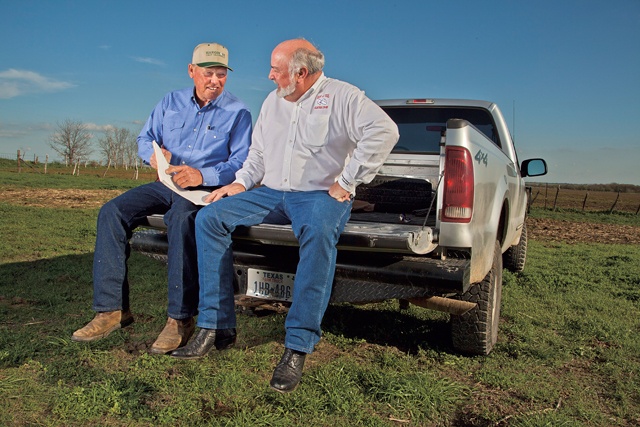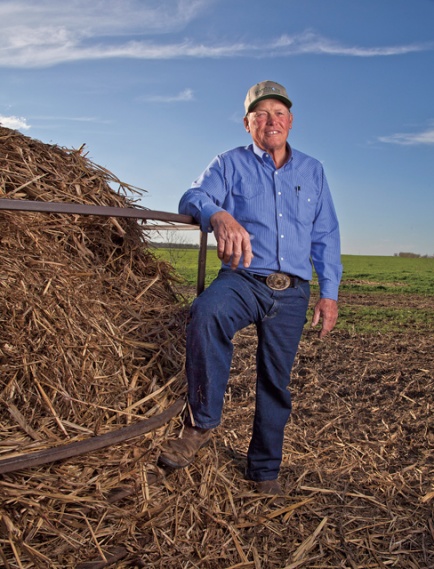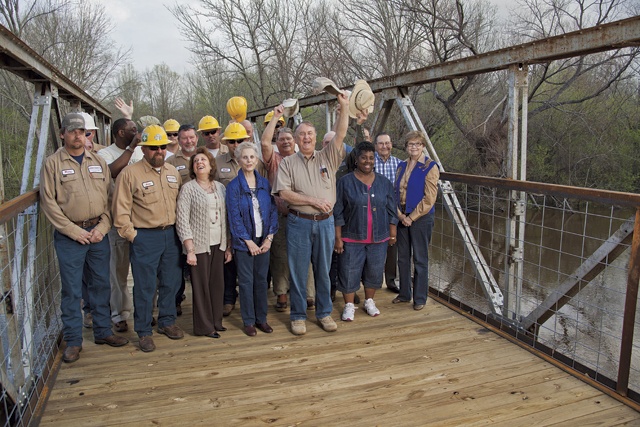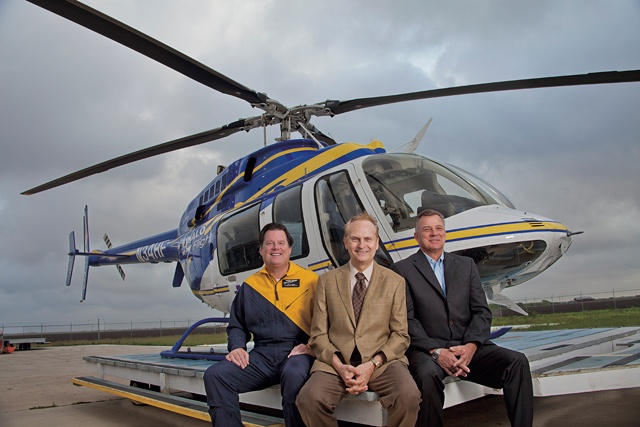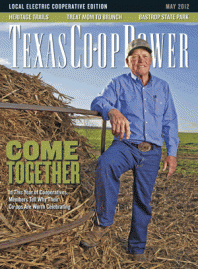On a gray and rainy Tuesday in mid-November, people poured into an East Texas gymnasium, where a sea of folding chairs covered the floor of perhaps the largest meeting space within 10 counties.
They came for the annual meeting of Sam Houston Electric Cooperative near Livingston. More than three hours before the official start, Cleo Railey arrived, the first of what would be a standing-room crowd of more than 1,100 co-op member-customers and their families.
Why come so early and on such a dreary day? “I just sat and visited with everyone,” Railey said following the meeting as she clutched a door prize and beamed after catching up with friends and co-op employees.
Railey expressed the essence of what makes a co-op different: Electric cooperatives are part of the essential glue that holds a community together, and it’s a role that co-ops like Sam Houston EC proudly work to live up to.
With the United Nations having designated 2012 as the International Year of Cooperatives, we asked members of Texas electric co-ops what they value about their co-op and about being members.
Across the state, they offered many reasons: “My co-op provides good service.” We also heard: “they’re responsive,” “managed by good people” and “they’re good for our community.”
Railey put it this way: “If you have a problem, they’re Johnny-on-the-spot.”
Are co-ops really so special? In a word: Yes. For one thing, co-ops are a special kind of business. They use a different business model from many other companies: They are democratically governed, operate on an at-cost, not-for-profit basis and work for the benefit of their members and communities—not single owners or stockholders. These are not empty promises; these are among the seven principles a co-op must embody to rightfully be called a cooperative.
Democracy Rules
Co-ops are democratically controlled. If you are a customer of a co-op, you are a member, and members have a vote in the direction their business takes. Democratic Member Control, one of the co-op principles, means you elect fellow members to serve on the co-op’s board of directors.
In practice, Democratic Member Control can take some interesting turns. Consider Bluebonnet Electric Cooperative’s annual meeting in May 2008 when a routine call went out for last-minute nominations from the floor to serve on the 11-member board.
Usually such an announcement goes without fanfare because the nominees are selected through a process stipulated in the co-op’s bylaws and publicized in time for the annual meeting. But there’s always the chance for an 11th-hour candidate.
That’s exactly what happened when Bluebonnet EC member Mike Hopkins stood up to nominate Robert Mikeska. If anybody knew Mikeska it was Hopkins; he employed Mikeska as a senior vice president at his Washington County beverage distributorship. Mikeska also had a long history of public service as a former Washington County commissioner and Brenham City Council member.
The voting went without a hitch, with co-op staff passing around linemen hard hats to collect the ballots. When all the votes were counted, Mikeska was elected as a write-in candidate and became the co-op’s newest board member.
“It illustrates to folks that the process is open,” Mikeska said. “Any member can get their name on the ballot. There is such a wide-open transparency in the organization.”
Mikeska said he was motivated to run because he believed his financial planning and local government experience provided an opportunity to serve others. After being re-elected to another three-year term last year, Mikeska said he is putting his skills to work more than ever as Bluebonnet recovers from September’s unprecedented wildfires that devastated a chunk of its service territory in Bastrop County.
Responding to Ranchers
Co-op members who ranch for a living have been among the hardest hit during a prolonged drought that intensified in 2011. The soaring heat and lack of rain left pastures bare and stock tanks empty, forcing many ranchers—faced with higher prices for water, hay and feed—to sell all or parts of their herds at depressed prices.
Ranchers in Central Texas served by Heart of Texas Electric Cooperative banded together to seek approval from the City of Rosebud to use untreated water from Rosebud Lake for their livestock.
The city approved the request, but the ranchers had to find a way to get the water out. Enter Heart of Texas EC, which agreed to supply power to a water pump at the lakeside. The McGregor-based co-op quickly dispatched a crew to install a pole and meter and run a line to the pump at a storage tank. The co-op’s Operation Round Up program—funded by members who round up to the nearest dollar when paying their monthly bills—now covers the cost of the electricity to run the pump each month.
Leslie Lorenz, a rancher who serves as coordinator of the emergency water program, said the co-op imposed no delays or red tape on the project at a time when speed was crucial.
Within 24 hours of the request, Heart of Texas CEO/Manager Rick Haile approved it, said Bryan Chandler, the co-op’s district line superintendent. “If it’s for the members, he’s all for it,” Chandler said. “That’s what’s good about being a cooperative. We have control to make decisions. We don’t have to go any further.”
Lorenz said the water project, which is continuing this year, has helped him and other ranchers maintain their herds.
“I hauled 1,200 to 1,400 gallons a day. I went twice a day. I held onto my cattle,” Lorenz said. “Sometimes, there’d be two or three people waiting in line. We’d meet there—local ranchers and neighbors—and we’d visit until one [tank] was full, and we’d say, ‘See you tomorrow.’ Kind of like a local coffee shop at the local water line.”
Lorenz speculated that other electricity providers would have declined or unduly delayed the project. In a day when large competitors have scaled back or closed branch offices, co-ops are a local presence, neighbors with a direct interest in the well-being of their community.
In fact, Lorenz said he often talks co-op business with his neighbor, Larry Stock, who serves on Heart of Texas’ board of directors.
“He’s a rancher, too,” Lorenz said. “We talk over the fence post. If something is going on, he brings it up at the board of directors’ meeting.”
The Locals Have It
Time and again, co-op members say they prize local accountability of their co-op, which gives members access and goes a long way toward getting things done.
Buddy Alders, a member of Houston County Electric Cooperative who lives near Madisonville in Madison County, can directly compare the service he gets from Houston County EC—the co-op that supplies electricity at his ranch home—and that from a neighboring utility which serves a construction business he owns in Dayton.
Alders cited a recent example: His employees needed to have a utility pole moved at a subdivision. It took many calls, a monthlong delay and too much money to get the job done, he complained. If he were dealing with Houston County EC, he could have had it taken care of as he had done before: with a short meeting at the co-op’s Crockett offices with General Manager Melody Pinnell or Line Superintendent Jack Vickers.
“We would have gotten it done in a week, and it wouldn’t have cost $1,100,” Alders said. “I’m a rural person. And this is a tremendous advantage for rural electric co-ops—they give service at a time service is almost a forgotten thing.”
On the South Plains, Paul Wilson tells a similar story.
Wilson is general manager of United Cotton Growers Cooperative in Levelland, one of the state’s largest farmer-owned cotton gins. The cotton co-op also is a member of Tahoka-based Lyntegar Electric Cooperative, which provides electricity to a large area south of Lubbock.
A few years ago, Lyntegar proposed a rate change that would have increased the expenses of Wilson’s and other cotton gins, especially when gins test new equipment during the summer. United Cotton Growers and other gins requested a meeting with the co-op to discuss the proposed increase.
“It was not contentious at all,” Wilson said of the meeting with Lyntegar CEO Greg Henley and staff members, in which an agreement was worked out that all the parties liked.
“They encouraged the dialogue,” Wilson said. “Small businesses were able to get together and influence the co-op’s decision, and they were able to do it because we’re member-owners and they want to please us. And that’s the real advantage of being a member of Lyntegar.”
Wilson is a cheerleader for the co-op business model. In addition to running one of the state’s largest cotton gin co-ops with 535 member-owners, his co-op is a member of a cottonseed oil cooperative, a cotton-marketing co-op and a cooperative warehouse. Many members also belong to credit unions (which are member-owned banking co-ops) and a Tahoka-based co-op that provides phone and high-speed Internet service (Poka Lambro Telephone Cooperative). Wilson explained that rural communities embraced co-ops generations ago when farmers felt they were being ignored or treated unfairly by large utility companies.
Wilson said co-ops provide more benefits than other companies: first, by giving members a say in how it’s run and, second, by returning margins (called capital credits at electric co-ops and dividends at cotton co-ops) to members. Capital credits come from the money left over after all of a co-op’s expenses are paid in a given year.
“Being a co-op means we are owners. So I have influence. We know who is on the board, and we vote for the ones who would represent us best,” Wilson said. “The reason I like Lyntegar is because they know we are the owners, we have input, and they listen to us.”
Returning Money to Members
Being accountable to fellow members makes all the difference in how a co-op is run, said Mack Rose, who operates a bass fishing guide service on Sam Rayburn Reservoir.
In 2010, Rose, a former Jasper County commissioner, won an election against four others for a seat on the board of his co-op, Jasper-Newton Electric Cooperative.
Last year, the board deemed that Jasper-Newton EC was in sound financial shape and voted to return to members $1 million in the form of credits on their summer electricity bills. “I’m proud of that,” Rose said. “We want to run this as efficiently as possible. … We’re not in it for profits.”
At co-ops, positive cash flow—a necessary requirement for the bond and loan markets—funds maintenance and improvements to the system of wires and equipment that deliver electricity. Income generated over expenses goes back as an investment in the cooperative and, eventually, is returned to member-customers as capital credits.
Community First
Co-ops support projects that improve the quality of life for their members and communities. They provide scholarships to students, funded by unclaimed capital credits and voluntary contributions, and grants to local community organizations and contribute money to help volunteer fire departments, food banks, emergency medical services, libraries, schools and countless worthy causes.
While many of these are ongoing efforts, co-ops are often called to help with unexpected projects. For example, the City of Mineola had been looking for a new home for a 60-foot-long, 30,000-pound historic bridge that had been idle after being replaced by a concrete one. City officials decided to install the bridge over the IG&N railroad slough at the Mineola Nature Preserve on the Sabine River, a 3,000-acre parcel being developed into a public wildlife and recreational space.
But before the bridge could be relocated, a sturdy piling structure needed to be built for its foundation. The little city of 4,500 residents didn’t have the money to hire outside contractors to perform the work.
So Mineola Mayor Bo Whitus turned to Wood County Electric Cooperative, based in nearby Quitman. Though the co-op doesn’t provide electricity inside Mineola city limits, it supplies power to the Nature Preserve and most of the rest of the county, and many of its members support the wildlife preserve and work in the city.
Wood County EC CEO/General Manager Debbie Robinson put the mayor in touch with a co-op supervisor whom Whitus knew. As soon as the utility construction crew had a little downtime, they spent two days in August 2010 in the heavily wooded nature preserve using a digger truck to dig 8-foot-deep holes for 27 poles to support the bridge and walkway.
“They just seem to be looking for opportunities to assist,” Whitus said. “You can’t imagine how thrilled I was when they showed up. We had been pondering this for a long time.” It was the second time the co-op has assisted with a project at the preserve. In 2009, workers installed a cable swing bridge. “It’s a big attraction for youngsters,” Whitus said.
At a time when big utilities have pulled out of local service areas and operate from call centers, co-ops provide a strong, ongoing local presence. “I really believe that co-ops have become the economic engines in a lot of communities,” said Kerry Kelton, general manager of Navasota-based Mid-South Synergy, which provides electricity, Internet and water services to members in six counties in Southeast Texas.
Mid-South and other co-ops employ highly skilled workers, such as electrical engineers, computer programmers and power technicians, Kelton said. These employees have helped the co-op adopt new technologies such as smart metering and “pay-as-you-go” billing, which allow users to better manage their electrical use online and receive automated notifications by text, email or phone when a prepaid balance is reached.
Nationwide, electric co-ops lead the way in smart-grid implementation, with about half of the co-ops having installed advanced metering infrastructure and 30 percent integrating it or automated meter-reading devices with various software applications, such as outage management and geographic information systems.
Seemingly small efforts by co-ops can make big impressions in their communities.
In Gail, Lyntegar EC ran an electrical line up a prominent hill on the outskirts of the small West Texas town to power a 20-foot star to promote a Lights for Gail celebration at the courthouse square. Every holiday season for the past 18 years, the star has shined down on the community celebration, said Borden County Judge Ross Sharp. “They stepped up,” said Sharp, who also mentioned numerous other ways the co-op supports local causes, from junior livestock shows to 4-H programs.
In McGregor, the city boosters rely on Heart of Texas EC crews in bucket trucks to install banners promoting the Founders’ Day celebration each September and outdoor lighting on downtown buildings at Christmastime, said John Sneed, treasurer of the McGregor Chamber of Commerce. Such work was once performed by the utility that has traditionally served the city proper, but Heart of Texas EC stepped in after that utility scaled back services, Sneed said.
“They live here, they work here, and their members value that kind of service,” Sneed said of the co-op, which provides electricity to his home just outside of town. “They are a valuable employer. They hire electricians and other office and support staff.”
Saving Lives
In 2010, Nueces and San Patricio electric cooperatives separately entered into agreements with a nonprofit air ambulance service, HALO-Flight, to fly members to hospitals in case of major medical emergencies. Instead of the $10,000 or more typical cost of such a helicopter flight, members pay just a $1 monthly subscription fee.
“We were very excited when HALO-Flight approached us with the idea,” said San Patricio EC General Manager Ron Hughes. “About 10 percent of our membership now participates in the HALO-Flight program. Partnering with San Patricio Electric to bill the monthly fees has helped the program generate additional revenues, while at the same time giving our members access to the services at reduced rates.”
The Nueces EC board agreed to offer the program, in which the co-op handles billing, because so many members live in areas far from medical facilities and with limited ambulance service, said John Sims, CEO of Nueces EC. The co-op has supported the nonprofit group since 1996 with annual grants from its Operation Round Up, funds that helped HALO-Flight secure its first helicopters, said Sarah Fisher, chief compliance officer with Nueces EC.
The new service has already made a difference: Several co-op members who subscribed have been airlifted to major hospitals because of medical emergencies. “Lives were saved and prolonged,” said Hillary Reyna, membership director for Corpus Christi-based HALO-Flight.
Satisfaction Index Has Co-ops at Top
As dramatic are the stories of rural people getting electricity from co-ops in the 1930s, many of today’s co-op members are far removed from the farm. Many have relocated to areas outside cities that have become suburbanized to find that their electric service is now provided by a co-op. Busy customers just want their electrical power and may not ever intend to vote or attend a co-op meeting.
Well, if you simply compare co-ops head-to-head with other utilities, there is strong evidence co-ops are doing right by member-customers in providing essential electrical service, which in the utility business comes down to delivering electricity affordably and reliably.
Nationwide, an alliance of electric cooperatives collectively scored the highest in customer satisfaction among all types of electric providers, according to The American Customer Satisfaction Index, a national economic indicator of customer evaluations of products and services.
In 2011, the customer satisfaction index—which was expanded last year to include consumer-owned cooperative utilities—showed co-ops with a top score of 82 (on a scale of 0 to 100), eight points higher than investor-owned utilities and nine points higher than municipally owned utilities, according to the independent survey that was created by the business school at the University of Michigan. Among cooperatives, Touchstone Energy Cooperatives, an alliance of more than 700 local U.S. electric cooperatives, including 47 in Texas (and all the co-ops mentioned in this story) led at 83—the best score of any energy utility, regardless of category.
“As is true for many other industries, smaller appears to be better,” the researchers said in summarizing the findings.
Response to Power Outages
For electrical utilities, swift response to a power outage is the hallmark of good customer service.
Last November, some of Sam Houston EC members arriving for the annual meeting had damp, grateful eyes as they greeted Keith Stapleton, who serves as the co-op’s chief communications officer. Still on their minds, Stapleton said, was the co-op’s response to Hurricane Ike, the September 2008 storm that pummeled East Texas and knocked out power to every one of the co-op’s 67,000 electrical meters.
Members recall co-op employees’ tireless efforts to restore power as the storms from Ike followed a devastating path up the U.S. Highway 59 corridor, through the center of Sam Houston’s system. The co-op put in action a well-thought-out logistical plan that it improved since a similar experience following Hurricane Rita in 2005. It set up camps and tent cities to house 3,000 workers, some of whom came in convoys from other co-ops nationwide. It also deployed teams of loggers to help clear tens of thousands of downed trees from power lines and roads. Costing more than $50 million, the restoration was the most expensive event in co-op history. But it paid off: Power was restored to all customers within 12 days, up to three days sooner than to customers who were served by other nearby utilities, Stapleton said, citing accounts in Houston newspapers that closely followed the response to the outage.
Scores of members sent letters and emails to thank co-op employees for working around-the-clock to bring back power. “Your hard work and dedication to your job has stopped us in our tracks on more than one occasion during the power outage,” lifelong Livingston resident Janie Kessler wrote in an email. “If we could stand as one and applaud, it would be a resounding roar.”
Later I spoke on the phone with Kessler, who confessed she usually is known for “telling it like is.” But she softens when asked about Sam Houston EC, which she and other members affectionately refer to as SHECO.
“I just know they are there,” Kessler said. “It’s like having a security blanket. You know they are there, and they are going to do their job.”
To Stapleton, seeing tears in the eyes of meeting attendees three years after Ike, communicated something without words. It said: “We know you are one of us—that we are all in this together.”
——————–
Charles Boisseau is an Austin-based writer.
